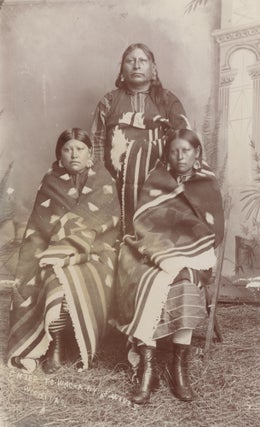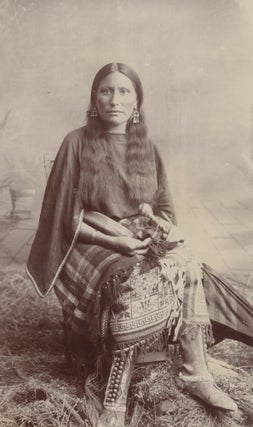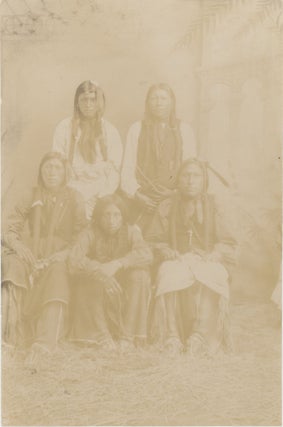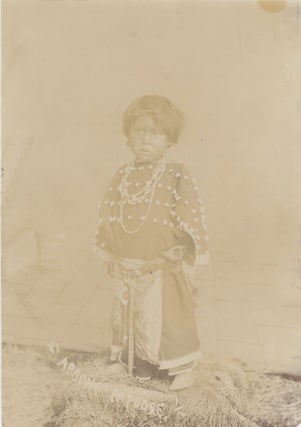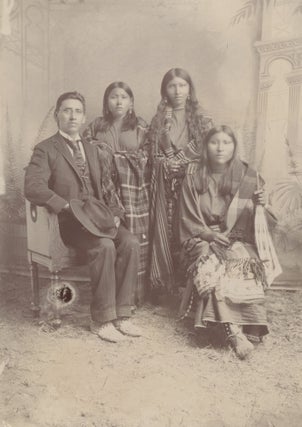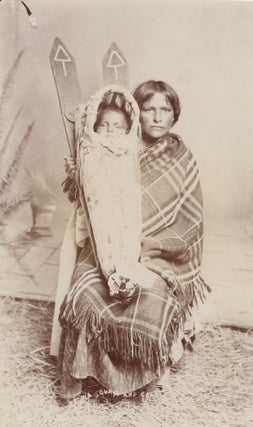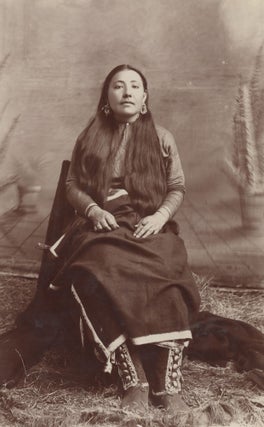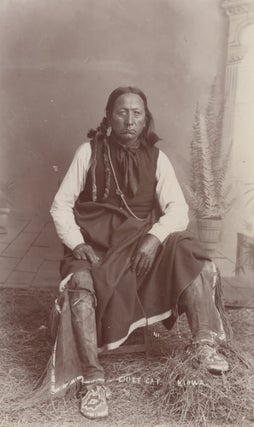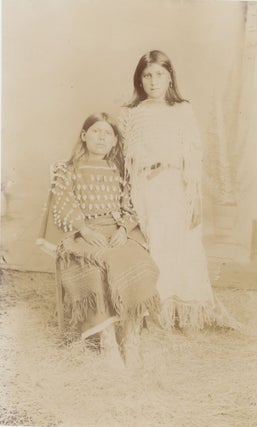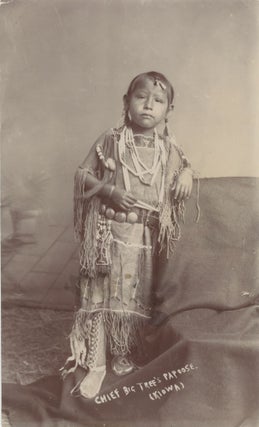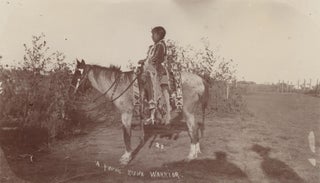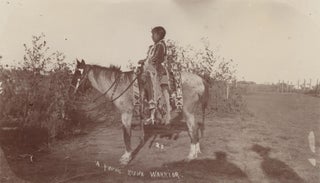Collection of Thirty Original Photographs of Native American Subjects Including Kiowa, Comanche and Wichita by the Lenny and Sawyers Photographic Firm in Oklahoma Territory, c. 1890s-1900.
Purcell: 1890-1900. Unmounted gelatin silver prints and one mounted boudoir card, most images measuring 8 x 5 and 7 x 4 ½ inches. Varying levels of fading, else about fine. With gallery stamps of Fenn Gallery, Santa Fe verso. Near Fine. Item #List1916
In the years following the Land Run of 1889, which opened land in Indian Territory to Euro-American settlement, professional and amateur photographers alike moved to the region. Their motives varied, with some attempting to document the vanishing indigenous culture and others trying to capitalize on the Euro-American demand for photographs of Native Americans in both traditional and western attire. Some studios would use single sets of props for different tribes. Despite these issues, the images from the period do illuminate the period of acculturation and displacement in the history of the Southern Plains Indians tribes, and also provide a record of the motives of the Euro-American photographers behind the camera.
William J. Lenny and William L. Sawyers were photographers working out of Purcell in the years immediately following the land rush. They photographed the tribes on the Kiowa-Comanche-Apache and Wichita-Caddo reservations. Lenny was a field photographer and likely took most of the photographs, while Sawyer managed the studio. Offered here are a very extensive group of photographs taken by the duo - twenty-seven in total - giving a visual record of the Kiowa and other tribes during this period. Some of these images - though not these copies - were included in the Museum of the Great Plains Exhibition In Citizen’s Garb, and we have included their reference numbers where applicable.
Overall an uncommonly large group in fine condition, with some fading. From the collection of Forest Fenn, the noted Santa Fe gallerist.
1. Indian Police / Kiowa and Comanches [Supplied Title]. The images shows seven mounted police officers, with the one furthest to the left appearing to be Euro-American.
2. Arko, Captain of the Indian Police (Comanche.) [Supplied Title] Indian police commonly earned $8-$10 per month to work on the reservation, where their duties included expelling intruders, bringing children to the schools, curbing crime and preventing the sale of alcohol. He’s dressed traditionally including a single feather worn as a headdress. [In Citizen’s Garb 32]
3. Chief Tow-Wac-A-Ny and Wives. Wichitas. [Supplied Title]. A portrait of ‘Towacany Jim,’ a famous military scout, posed with a Navajo-style blanket along with his two wives. The women are wearing purchased shoes common in this period. He earned $10 per month as leader of the Indian Police and traveled to Washington, D.C. on diplomatic missions. Fine contrast.
4. Big Tree’s Boy and Girl. Kiowas. [Supplied Title] A portrait of two children of the chief Big Tree. The pair wear traditional dress. Faded.
Big Tree.
5. Kiowa Chief. [Supplied Title] A portrait of A’Do-Ette, or Big Tree, the Kiowa chief. Fine contrast.
6. [Portrait of A’Do-Ette] . He wears the same costume used by the photographers for various other tribal leaders, including a large headdress. Faded.
7. Chief Big Tree’s Daughters. (Kiowas.) [Supplied Title] The image shows two girls identified as Alma (left) and Leena (right). Alma wears a dress of dark buckskin. Both girls have beaded bags, known as “Strike-a-Light” bags hanging from belts.
8. Lone Wolf. Kiowa Chief. [Supplied Title] A photograph of Mamay-day-te, or Lone Wolf the Younger, in the same costume used for O’Do-Ette’s portrait and others. Some fading.
9. Photograph of Laura Dunmore, or Laura Pedrick. Dunmore was a graduate of Carlisle School and sister of Chief Aptone. She is pictured here with a parasol, tartan cloth and tinkling cone earrings, providing a striking study in fashion during this period. Fine contrast.
10. Photograph of a Camp Scene in Summer on a Reservation. This scene, perhaps a Kiowa-apache camp, contains a tipi made of canvas instead of hides. A man in an expensive set of purchased clothing sits in the foreground. Excellent contrast. [In Citizens Garb 9]
11. Photograph of a Camp Scene in Summer. A variant of our no. 10, showing the same scene from a different angle. Excellent contrast.
12. Chief Wild Horse [Supplied Title] Title written in ink on margin. A photograph of Kobay-O-Burra, second chief of the Quahadi, who took over principal chieftanship when Parra-o-Coom died in 1874.
13. Photograph of Mamay-Day-Te (Lone Wolf). A variant pose as number 8 with the same dress.
14. Photograph of Five Comanche in Mixed Attire. They have been identified as Pah-do-pony (top left), To-pooh (bottom right), and Big Kiowa (bottom left, brother of Pah-do-pony and Perk-a-Quannard). (In Citizens Garb 14)
15. Apache Papoose [Supplied Title]. A photograph of a child in traditional dress. Faded.
16. Photograph of Four Indigenous Subjects in Mixed Attire. A portrait of a man and three women, the man in a Euro-American style suit and the women in a mix of traditional dress using trade fabrics. Excellent contrast.
17. Portrait of an Unidentified Man. A portrait of a man in heavy fringe, breechcloth and fringed leggings. This was marketed under the name “Big Tree’s Son” in the 1890s and the subject is identified as Kiowa in the In Citizens Garb catalog. [In Citizens Garb 16)
18. Kiowa Squaw and Papoose [Supplied Title]. A photograph of a woman and a child in a studio setting. Very good contrast.
19. Portrait of Zah-Tay or Lizzie Woodward. Zah-Tay appeared in other photographs with her niece and son.
20. Portrait of Cora Caruth. A portrait identified as Cora Caruth, who graduated from an Indian School, perhaps Carlisle, and eventually worked as an interpreter for Wichita at Anadarko. Fine contrast.
21. Portrait of a Man in a Serape. A portrait of a seated man in a serape, or striped Mexican blanket. A breechcloth, legging and moccasins can be seen under the serape. (In Citizens Garb 23)
22. Chief Cat. Kiowa. [Supplied Title] A photograph of Ba’o (Cat) also Goon-Saudle-Te, who wandered from camp in Colorado when he was twelve and was not recovered for five years. Comanches sheltered him. Fine contrast.
23. Kiowas. [Supplied Title] A portrait of Lizzy Woodward, Oliver and her niece posed in Kiowa clothing. Oliver is in a beaded cradleboard, Lizzy’s dress was tied with Tartan cloth, and wears traditional Kiowa moccasins. (In Citizen’s Garb 10)
24. Portrait of Lizzy Woodward, Her Niece and Oliver. A variant of our no. 23, with Oliver and Woodward in different dress. Fine contrast.
25. Portrait of Two Kiowa Girls. Two girls pose, one in buckskin dress decorated in paint. Buckskin would become less frequent. Fading. (In Citizen’s Garb 2)
26. Big Tree’s Papoose. (Kiowa). [Supplied Title]. A portrait of Alma, later known as Mrs. Ahote. Fine contrast.
27. Kiowa Braves. [Supplied Title] A photograph of two young men on horseback. Very good contrast to foreground, slight fading to background.
28. A Young Kiowa Warrior [Supplied Title]. A photograph of Enoch Smokey, later known as Apenguadal, who lived near Verden, Oklahoma. His mother was noted as a beadworker and his horse is fitted with unusually decorative gear. His personal dress includes a hairpipe breastplate and a pelt around his arms. (In Citizens Garb 36)
29. Portrait of a Standing Kiowa Man. He wears the same headdress used in other studio photographs. Some fading.
30. Unidentified Man, Possibly Euro-American, Posed in a Headdress in Studio Setting. This is a mounted image, unlike the others, with the Lenny & Sawyers mount. The subject appears to be Euro-American and wears the same headdress used by the Indigenous subjects in several of the earlier photographs. He holds a prop bow and arrow.
An uncommonly large group of images, which in total provide an impressive visual record of this period of forced acculturation and transition in dress.
Price: $12,500.00




